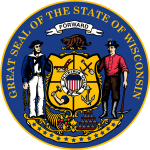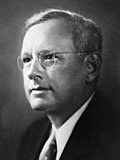| ||||||||||||||||||||||||||
| ||||||||||||||||||||||||||
 County Results
| ||||||||||||||||||||||||||
| ||||||||||||||||||||||||||
| Elections in Wisconsin |
|---|
 |
The 1936 United States presidential election in Wisconsin was held on November 3, 1936 as part of the 1936 United States presidential election. State voters chose 12 electors to the Electoral College, who voted for president and vice president.
Wisconsin had since the decline of the Populist movement been substantially a one-party state dominated by the Republican Party.[1] The Democratic Party became entirely uncompetitive outside certain German Catholic counties adjoining Lake Michigan as the upper classes, along with the majority of workers who followed them, completely fled from William Jennings Bryan's agrarian and free silver sympathies.[2] As Democratic strength weakened severely after 1894 – although the state did develop a strong Socialist Party to provide opposition to the GOP – Wisconsin developed the direct Republican primary in 1903 and this ultimately created competition between the "League" under Robert M. La Follette, and the conservative "Regular" faction.[3]
The beginning of the 1910s would see a minor Democratic revival as many La Follette progressives endorsed Woodrow Wilson,[4] but this flirtation would not be long-lasting as Wilson's "Anglophile" foreign policies were severely opposed by Wisconsin's largely German- and Scandinavian-American populace.[5] Subsequent federal elections saw the Midwest desert the Democratic Party even more completely due to supposed preferential treatment of Southern farmers,[6] and in Wisconsin there were never more than three Democrats in the state legislature (and none in the State Senate) between 1921 and 1929.
The Great Depression radically altered the state's politics, as the La Follette family did not support President Herbert Hoover in 1932, with the result that he lost to Democrat Franklin D. Roosevelt by two-to-one. Following a brief Democratic interlude after the 1932 elections, Robert M. La Follette, Jr. formed the Wisconsin Progressive Party and during the 1934 midterm elections that party captured seven of Wisconsin's ten House of Representatives seats and most statewide offices under a platform of improved land conservation and a federal referendum and initiative system.[7] La Follette, despite his respect for Union Party nominee William Lemke, strongly endorsed Roosevelt,[8] whilst Landon based his hopes on traditional Democrats responding to Al Smith's backing of him and the state's farmers' dislike of trade treaties as reducing their access to foreign markets.
At the beginning of the poll it was thought that Union Party candidate Lemke would threaten Roosevelt's hold on Wisconsin's electoral votes as the Midwest had gone through a record heatwave and extreme drought.[9] Republican nominee Alf Landon campaigned in Wisconsin in late September, arguing that Roosevelt's trade agreements with Canada were hurting Wisconsin's farmers,[10] and that racial tolerance in a state where virtually all areas outside inner Milwaukee had become sundown towns[11] alongside academic freedom were critical issues for the state and the nation.[12] Landon did receive a good reception in Milwaukee, but had his hotel invaded in Oshkosh.[12] Senator La Follette did much of the campaigning for Roosevelt in the state, whilst the President focused his campaign on other states of the Midwest.[13]
Late in September, polls showed Roosevelt narrowly leading Landon,[14] although a Gallup poll showed him increasing his lead in Wisconsin.[15] Although no later polls were conducted, as it turned out Roosevelt won convincingly and held his two-to-one 1932 margin, carrying all but four counties. Vis-à-vis the 1932 election, Roosevelt gained significantly in the industrial areas of the northwest – in Douglas County he gained 24 percent on his 1932 figures – and in the urban southeast,[16] but lost in the rural areas lying between these two groups. A substantial vote for Lemke from isolationist German Catholics would pave the way for the traditionally Democratic areas in the east to permanently leave the party with the following election, as this group could not accept the urban bias of the New Deal.
Roosevelt was the first Democrat since Franklin Pierce in 1852 to carry Rock County. As of 2020, this remains the strongest performance by a Democrat in Wisconsin.[17]
- ^ Burnham, Walter Dean; 'The System of 1896: An Analysis'; in The Evolution of American Electoral Systems, pp. 178-179 ISBN 0313213798
- ^ Sundquist, James; Politics and Policy: The Eisenhower, Kennedy, and Johnson Years, p. 526 ISBN 0815719094
- ^ Hansen, John Mark; Shigeo Hirano, and Snyder, James M. Jr.; 'Parties within Parties: Parties, Factions, and Coordinated Politics, 1900-1980'; in Gerber, Alan S. and Schickler, Eric; Governing in a Polarized Age: Elections, Parties, and Political Representation in America, pp. 165-168 ISBN 978-1-107-09509-0
- ^ Crews, Kenneth D.; 'Woodrow Wilson, Wisconsin, and the Election of 1912'; Presidential Studies Quarterly, Vol. 12, No. 3: 'Presidents, Vice Presidents and Political Parties: Performance and Prospects' (Summer, 1982), pp. 369-376
- ^ Leary, William M. (jr.); 'Woodrow Wilson, Irish Americans, and the Election of 1916'; The Journal of American History, Vol. 54, No. 1 (June 1967), pp. 57-72
- ^ Morello, John A.; Albert D. Lasker, Advertising, and the Election of Warren G. Harding, p. 64 ISBN 0275970302
- ^ Janus, Erika; A Short History of Wisconsin, p. 138 ISBN 0870204734
- ^ 'Roosevelt Assets Large in Wisconsin: Backed by La Follettes and Labor, His Forces Count on Retaining State'; The New York Times, October 22, 1936, p. 13
- ^ Blair, Edson; 'Washington: Both Sides of the Curtain: Lemke's Part in the National Election Campaign – La Follette and Discriminating Wisconsin Voters – Landon and Illinois'; Barron's (Boston, Massachusetts), August 24, 1936, p. 4
- ^ Hagerty, James A.; 'Drive in Wisconsin Began by Landon: Leaders Pledge State Victory When They Board His Train on Way to Milwaukee'; The New York Times, September 26, 1936, p. 1
- ^ See Loewen, James W.; Sundown Towns: A Hidden Dimension of American Racism, pp. 56, 68 ISBN 1595586741
- ^ a b 'Landon Demands Racial Tolerance: In Wisconsin Wayside Talks Candidate Also Calls for Academic Freedom'; Special to The New York Times, September 27, 1936, p. 30
- ^ 'La Follette Urges Roosevelt Return: Senator Radios a Call From Chicago to All Liberals to Back the President'; The New York Times, September 29, 1936, p. 23
- ^ 'Close Race Seen in Four States Landon Will Visit: Trend of Democratic Popularity in Four States'; Daily Boston Globe, September 22, 1936, p. 3
- ^ Gallup, George; 'Roosevelt Is Gaining According to Nationwide Poll: Delaware, Minnesota Shift Gives 306 Electoral Votes'; Daily Boston Globe, October 4, 1936, p. 5
- ^ Phillips, Kevin P.; The Emerging Republican Majority, pp. 387-388 ISBN 978-0-691-16324-6
- ^ "Dave Leip's Atlas of U.S. Presidential Elections". uselectionatlas.org. Retrieved December 29, 2022.


